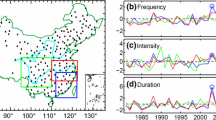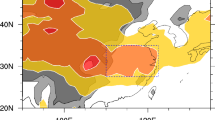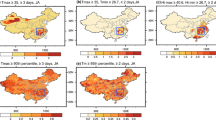Abstract
This study explores the main drivers of heat wave (HW) events in central Chile using state-of-the-art reanalysis data (ERA5) and observations during the extended austral summer season (November to March) for the period 1979–2018. Frequency and intensity aspects of the HW events are considered using the total number of the HW events per season and the amplitude. We first contrast ERA5 with several surface meteorological stations in central Chile to evaluate its ability to capture daily maximum temperature variability and the HW events. We then use synoptic- and large-scale fields and teleconnection patterns to address the most favorable conditions of the HW events from a climatological perspective as well as from the extreme January 2017 HW event that swept central Chile with temperature records and wildfires. ERA5 tends to capture temperature extremes and the HW events at the inland stations; on the contrary, it has difficulties in capturing the maximum temperature variability at the coastal stations, which is plausible given the complex terrain features and confined coastal climate zone (only \(\sim \)7% of all grid boxes within central Chile). The composite HW days based on ERA5 reveals a mid-level trough-ridge dipole pattern exhibiting a blocking anticyclone on the surface over a large part of southwest South America. Relatively dry and warm easterly flow appears to accompany the anomalous warming in a large part of central Chile. The temporal evolution of the HW events yields a wave-like propagation pattern and enhancement of trough-ridge pattern along the South Pacific. This meridional dipole pattern is found to be largely associated with the Pacific South American pattern. In addition, the Madden–Julian Oscillation (MJO) appears to be a key component of the HW events in central Chile. In particular, while active MJO phases 2 and 7 promote sub-seasonal patterns that favor the South Pacific dipole mode, synoptic anomalies can superimpose on them and favor the formation of a migrating anticyclone over central-southern Chile and coastal lows over central Chile. Agreeing with the climatological findings, the extreme January 2017 HW analysis suggests that an eastward migratory mid-latitude trough-ridge pattern associated with MJO phase 2 was at work. We highlight that in addition to large- and synoptic-scale features, sub-synoptic processes such as coastal lows can have an important role in shaping the HW events and can lead to amplification of temperature extremes during the HW events.












Similar content being viewed by others
References
Aguirre C, García-Loyola S, Testa G, Silva D, Farias L (2018) Insight into anthropogenic forcing on coastal upwelling off south-central Chile. Elem Sci Anth 6(1):59. https://doi.org/10.1525/elementa.314
Alvarez-Castro MC, Faranda D, Yiou P (2018) Atmospheric dynamics leading to West European summer hot temperatures since 1851. Complexity p 2494509
Barrett BS, Hameed S (2017) Seasonal variability in precipitation in central and southern Chile: modulation by the South Pacific High. J Clim 30:55–69. https://doi.org/10.1175/JCLI-D-16-0019.1
Barrett BS, Fitzmaurice SJ, Pritchard SR (2012) Intraseasonal variability of surface ozone in Santiago, Chile: modulation by phase of the Madden–Julian Oscillation (MJO). Atmos Environ 57:55–62. https://doi.org/10.1016/j.atmosenv.2012.04.040
Barrett B, Campos DA, Veloso JV, Rondanelli R (2016) Extreme temperature and precipitation events in March 2015 in central and northern Chile. J Geophys Res Atmos 121:4563–4580. https://doi.org/10.1002/2016JD024835
Barrett BS, Marín J, Jacques-Coper M (2020) A multiscale analysis of the tornadoes of 30–31 May 2019 in south-central Chile. Atmos Environ 236(104):811. https://doi.org/10.1016/j.atmosres.2019.104811
Black E, Blackburn M, Harrison G, Hoskins B, Methven J (2013) Factors contributing to the summer 2003 European heatwave. Weather 49(8):217–223
Boisier JP, Rondanelli R, Garreaud R, Muñoz F (2016) Anthropogenic and natural contributions to the Southeast Pacific precipitation decline and recent megadrought in central Chile. Geophys Res Lett 43(1):413–421. https://doi.org/10.1002/2015GL067265
Boisier JP, Alvarez-Garreton C, Cordero R, Damiani A, Gallardo L, Garreaud R, Lambert F, Ramallo C, Rojas M, Rondanelli R (2018) Anthropogenic drying in central-southern Chile evidenced by long-term observations and climate model simulations. Elem Sci Anth https://doi.org/10.1525/elementa.328
Bowman DMJS, Moreira-Muñoz A, Kolden CA et al (2019) Human-environmental drivers and impacts of the globally extreme 2017 Chilean fires. Ambio 48:350–362. https://doi.org/10.1007/s13280-018-1084-1
Bozkurt D, Rondanelli R, Garreaud R, Arriagada A (2016) Impact of warmer eastern tropical Pacific SST on the March 2015 Atacama floods. Mon Weather Rev 144(11):4441–4460. https://doi.org/10.1175/MWR-D-16-0041.1
Bozkurt D, Rojas M, Boisier JP, Rondanelli R, Garreaud R, Gallardo L (2019) Dynamical downscaling over the complex terrain of southwest South America: present climate conditions and added value analysis. Clim Dyn 53:6745–6767. https://doi.org/10.1007/s00382-019-04959-y
Bureau M (2017) The Bureau of Meteorology: Australia in January 2017. http://www.bom.gov.au/climate/current/month/aus/archive/201701.summary.shtml. Accessed 7 Aug 2020
Burke M, Hsiang SM, Miguel E (2015) Global non-linear effect of temperature on economic production. Nature 527:235–239. https://doi.org/10.1038/nature15725
C3S (2017) ERA5: fifth generation of ECMWF atmospheric reanalyses of the global climate. Copernicus Climate Change Service (C3S) Climate Data Store (CDS)
Carrera N (2021) Caracterización de vientos puelche en el valle del Río Laja. Undergraduate Thesis, Department of Geophysics, Universidad de Concepción
Cassou C (2008) Intraseasonal interaction between the Madden–Julian Oscillation and the North Atlantic Oscillation. Nature 455:523–527
Cowan T, Purich A, Perkins S, Pezza A, Boschat G, Sadler K (2014) More frequent, longer, and hotter heat waves for Australia in the twenty-first century. J Clim 27(15):5851–5871. https://doi.org/10.1175/JCLI-D-14-00092.1
D’Ippoliti D, Michelozzi P, Marino C, de’Donato F, Menne B, et al (2010) The impact of heat waves on mortality in 9 European cities: results from the EuroHEAT project. Environ Health 9:37. https://doi.org/10.1186/1476-069X-9-37
de la Barrera F, Barraza F, Favier P et al (2018) Megafires in Chile 2017: monitoring multiscale environmental impacts of burned ecosystems. Sci Total Environ 638:1526–1536. https://doi.org/10.1016/j.scitotenv.2018.05.119
Dong L, Mitra C, Greer S, Burt E (2018) The dynamical linkage of atmospheric blocking to drought heatwave and urban heat island in Southeastern US: a multi-scale case study. Atmosphere 9:33
Dunn RJH, Alexander LV, Donat MG, Zhang X, Bador M, Herold N, et al (2020) Development of an updated global land in situ-based data set of temperature and precipitation extremes: HadEX3. J Geophys Res Atmos 125(16):263. https://doi.org/10.1029/2019JD032263
Falvey M, Garreaud R (2009) Regional cooling in a warming world: recent temperature trends in the southeast Pacific and along the west coast of subtropical South America (1979–2006). J Geophys Res Atmos 114(D04):102
Garreaud R (2020) Análisis: La “mancha cálida” del océano Pacífico y olas de calor en Chile | (CR)2. http://www.cr2.cl/la-mancha-calida-del-oceano-pacifico-y-olas-de-calor-en-chile/
Garreaud R, Aceituno P (2007) In: Veblen TT, Young KR, Orme AR (eds) The Physical Geography of South America, Chapter 3. Oxford University Press, Oxford
Garreaud R, Rutllant J (2003) Coastal lows along the subtropical west coast of South America: numerical simulation of a typical case. Mon Wea Rev 131:891–908
Garreaud R, Rutllant J, Fuenzalida H (2002) Coastal lows along the suptropical west coast of South America: mean structure and evolution. Mon Wea Rev 130:75–88
Garreaud R, Lopez P, Minvielle M, Rojas M (2010) Large-Scale Control on the Patagonian Climate. J Clim 26(1):215–230. https://doi.org/10.1175/JCLI-D-12-00001.1
Garreaud R, Alvarez-Garreton C, Barichivich J, Boisier JP, Duncan C, Galleguillos M, Zambrano-Bigiarini M (2017) The 2010–2015 mega drought in central Chile: impacts on regional hydroclimate and vegetation. Hydrol Earth Syst Sci 21:6307–6327
Garreaud RD, Boisier JP, Rondanelli R, Sepúlveda HH, Veloso-Aguila D (2019) The central Chile Mega Drought (2010–2018): a climate dynamics perspective. Int J Climatol 40(1):421–439. https://doi.org/10.1002/joc.6219
Geirinhas JL, Trigo RM, Libonati R, Castro LCO et al (2019) Characterizing the atmospheric conditions during the 2010 heatwave in Rio de Janeiro marked by excessive mortality rates. Sci Total Environ 650:796–808. https://doi.org/10.1016/j.scitotenv.2018.09.060
Gill AE (1980) Some simple solutions for heat-induced tropical circulation. Q J R Meteor Soc 106:447–462. https://doi.org/10.1002/qj.49710644905
Gillett NP, Kell TD, Jones PD (2006) Regional climate impacts of the Southern Annular Mode. Geophys Res Lett 33(L23):704. https://doi.org/10.1029/2006GL027721
González ME, Sapiains R, Gómez-González S, Garreaud R, Miranda A, Galleguillos M, Jacques-Coper M, Pauchard A, Hoyos J, et al (2020) Incendios forestales en Chile: causas, impactos y resiliencia. Center for Climate and Resilience Research, Universidad de Chile, Universidad de Concepción y Universidad Austral de Chile. http://www.cr2.cl/wp-content/uploads/2020/01/Informe-CR2-IncendiosforestalesenChile.pdf
Hersbach H, Bell B, Berrisford P, et al (2020) The ERA5 global reanalysis. Q J R Meteorol Soc 10:15. https://doi.org/10.1002/qj.3803
Holz A, Paritsis J, Mundo IA, Veblen TT, Kitzberger T, Williamson GJ, et al (2017) Southern Annular Mode drives multicentury wildfire activity in southern South America. Proc Natl Acad Sci USA 114:9552–9557. https://doi.org/10.1073/pnas.1705168114
Horton RM, Mankin JS, Lesk C, Coffel E, Raymond C (2016) A review of recent advances in research on extreme heat events. Curr Clim Change Rep 2:242–259. https://doi.org/10.1007/s40641-016-0042-x
Irving D, Simmonds I (2016) A new method for identifying the Pacific-South American Pattern and its influence on regional climate variability. J Clim 29(17):6109–6125. https://doi.org/10.1175/JCLI-D-15-0843.1
Jacques-Coper M, Brönnimann S, Martius O et al (2015) Evidence for a modulation of the intraseasonal summer temperature in Eastern Patagonia by the Madden–Julian Oscillation. J Geophys Res Atmos 120:7340–7357. https://doi.org/10.1002/2014JD022924
Jacques-Coper M, Brönnimann S, Martius O, Vera C, Cerne B (2016) Summer heat waves in southeastern Patagonia: an analysis of the intraseasonal timescale. Int J Climatol 36(3):4563–4580
Jacques-Coper M, Veloso-Aguila D, Segura C, Valencia A (2021) Intraseasonal teleconnections leading to heat waves in central Chile. Int J Climatol. https://doi.org/10.1002/joc.7096
Karl TR, Nicholls N, Ghazi A (1999) CLIVAR/GCOS/WMO workshop on indices and indicators for climate extremes: workshop summary. Clim Change 42:3–7
León-Muñoz J, Urbina MA, Garreaud R, Iriarte JL (2018) Hydroclimatic conditions trigger record harmful algal bloom in western Patagonia (summer 2016). Sci Rep 8(1):1330. https://doi.org/10.1038/s41598-018-19461-4
Matsueda S, Takaya Y (2015) The global influence of the Madden–Julian Oscillation on extreme temperature events. J Clim 28(10):4141–4151. https://doi.org/10.1175/JCLI-D-14-00625.1
Matsuno T (1966) Quasi-geostrophic motions in the equatorial area. J Meteorol Soc Jpn Ser II 44:25–43
Mo KC, Higgins RW (1998) The Pacific-South American and tropical convection during the Southern Hemisphere winter. Mon Wea Rev 126:1581–1596
Mo KC, Paegle JN (2001) The Pacific-South American modes and their downstream effects. Int J Climatol 21:1211–1229. https://doi.org/10.1002/joc.685
Montecinos A, Aceituno P (2003) Seasonality of the ENSO-related rainfall variability in central Chile and associated circulation anomalies. J Clim 16:181–296
Montecinos A, Muñoz RC, Oviedo S et al (2017) Climatological characterization of puelche winds down the western slope of the extratropical andes mountains using the NCEP climate forecast system reanalysis. J Appl Meteorol Climatol 56:677–696. https://doi.org/10.1175/JAMC-D-16-0289.1
Muggeo VM, Hajat S (2009) Modelling the non-linear multiple-lag effects of ambient temperature on mortality in Santiago and Palermo: a constrained segmented distributed lag approach. Occup Environ Med 66:584–591. https://doi.org/10.1136/oem.2007.038653
O’Kane TJ, Monselesan DP, Risbey JS (2017) A multiscale reexamination of the Pacific-South American Pattern. Mon Weav Rev 145(1):379–402. https://doi.org/10.1175/MWR-D-16-0291.1
Perkins SE (2015) A review on the scientific understanding of heatwaves-their measurement, driving mechanisms, and changes at the global scale. Atmos Res 164–165:242–267. https://doi.org/10.1016/j.atmosres.2015.05.014
Perkins SE, Alexander LV (2013) On the measurement of heat waves. J Clim 26:4500–4517. https://doi.org/10.1175/JCLI-D-12-00383.1
Peterson TC, et al. (2001) Report on the activities of the working group on climate change detection and related rapporteurs 1998–2001. WMO Tech. Report Rep. WCDMP-47, WMO-TD 1071, WMO, Geneve, Switzerland
Pezza AB, van Rensch P, Cai W (2012) Severe heat waves in southern Australia: synoptic climatology and large scale connections. Clim Dyn 38:209–224. https://doi.org/10.1007/s00382-011-1016-2
Pérez-Santos I, Seguel R, Schneider W, Linford P, Donoso D, Navarro E, Amaya-Cárcamo C, Pinilla E, Daneri G (2019) Synoptic-scale variability of surface winds and ocean response to atmospheric forcing in the Eastern Austral Pacific Ocean. Ocean Sci 15:1247–1266. https://doi.org/10.5194/os-15-1247-2019
Piticar A (2018) Changes in heat waves in Chile. Glob Planet Change 169:234–246. https://doi.org/10.1016/j.gloplacha.2018.08.007
Rahn DA (2012) Influence of large scale oscillations on upwelling-favorable coastal wind off central Chile. J Geophys Res Atmos 117(D19):114. https://doi.org/10.1029/2012JD018016
Risbey JS, Pook MJ, Mclntosh PC, Wheeler MC, Hendon HH (2009) On the remote drivers of rainfall variability in Australia. Mon Wea Rev 137(10):3233–3253
Risbey JS, O’Kane TJ, Monselesan DP, Franzke CLE, Horenko I (2018) On the dynamics of Austral heat waves. J Geophys Res Atmos 123(1):38–57. https://doi.org/10.1002/2017JD027222
Robertson AW, Mechoso CR (2003) Circulation regimes and low-frequency oscillations in the South Pacific sector. Mon Weav Rev 131:1566–1576. https://doi.org/10.1175//2548.1
Rondanelli R, Hatchett B, Rutllant J, Bozkurt D, Garreaud R (2019) Strongest MJO on record triggers extreme Atacama rainfall and warmth in Antarctica. Geophys Res Lett 46:3482–3491. https://doi.org/10.1029/2018GL081475
Rutllant J (1994) On the generation of coastal lows in central Chile. ICTP Tech. Note ICTP Internal Rep. IC/94/167, International Centre for Theoretical Physics
Rutllant J, Fuenzalida H (1991) Synoptic aspects of the central Chile rainfall variability associated with the Southern Oscillation. Int J Climatol 11:63–76
Rutllant JA, Garreaud R (2004) Episodes of strong flow down the western slope of the subtropical Andes. Mon Weather Rev 132(2):611–622
Sarricolea P, Herrera-Ossandon M, Meseguer-Ruiz O (2017) Climatic regionalisation of continental Chile. J Map 13:66–73. https://doi.org/10.1080/17445647.2016.1259592
Schneidereit A, Schubert S, Vargin P, Lunkeit F, Zhu X, Peters DH, Fraedrich K (2012) Large-scale flow and the long-lasting blocking high over Russia: summer 2010. Mon Weather Rev 140(9):2967–2981. https://doi.org/10.1175/MWR-D-11-00249.1
Silvestri G, Vera C (2009) Nonstationary impacts of the southern annular mode on Southern Hemisphere climate. J Clim 22(22):6142–6148. https://doi.org/10.1175/2009JCLI3036.1
Terray P, Delecluse P, Labattu S, Terray L (2003) Sea surface temperature associations with the late Indian summer monsoon. Clim Dyn 21:593–618. https://doi.org/10.1007/s00382-003-0354-0
Thompson DWJ, Wallace JM (2000) Annular modes in the extratropical circulation part I: month-to-month variability. J Clim 13(5):1000–1016
Trenberth K, Staff NR (2020) The Climate Data Guide: Nino SST Indices (Nino 1+2, 3, 3.4, 4; ONI and TNI), NCAR, Boulder. https://climatedataguide.ucar.edu/climate-data/nino-sst-indices-nino-12-3-34-4-oni-and-tni, Accessed 21 Jan 2020
Urrutia-Jalabert R, González ME, González-Reyes A, Lara A, Garreaud R (2018) Climate variability and forest fires in central and south-central Chile. Ecosphere 9(e02):171. https://doi.org/10.1002/ecs2.2171
Venegas SA (2001) Statistical methods for signal detection in climate. Danish Center for Earth System Science Rep. 2, 96 pp
Wheeler MC, Hendon HH (2004) An all-season real-time multivariate MJO index: development of an index for monitoring and prediction. Mon Weather Rev 132:1917–1932
Zeng C, Chang EK, Kim HM, Zhang M, Wang W (2018) Impacts of the Madden–Julian Oscillation on storm-track activity, surface air temperature, and precipitation over North America. J Clim 31:6113–6134. https://doi.org/10.1175/JCLI-D-17-0534.1
Zhang C (2005) Madden–Julian Oscillation. Rev Geophys 43(2):RG2003. https://doi.org/10.1029/2004RG000158
Acknowledgements
This work was partially funded by ANID/FONDAP/15110009. A. D. acknowledges l’Ecole Nationale de la Météorologie for a MSc research scholarship. D. B. acknowledges support from ANID/CONICYT (Grant No. 77190080), ANID/PIA/Anillo INACH ACT192057 and ANID/FONDECYT/11200101. M. J. C. acknowledges support from ANID/FONDECYT/11170486. ERA5 data is available on the Copernicus Climate Change Service (C3S) Climate Data Store: https://cds.climate.copernicus.eu/. Surface meteorological data was obtained from: https://climatologia.meteochile.gob.cl/. Multivariate MJO series were accessed from: http://www.bom.gov.au/climate/mjo/graphics/rmm.74toRealtime.txt
Author information
Authors and Affiliations
Corresponding author
Additional information
Publisher's Note
Springer Nature remains neutral with regard to jurisdictional claims in published maps and institutional affiliations.
Supplementary information
Below is the link to the electronic supplementary material.
Rights and permissions
About this article
Cite this article
Demortier, A., Bozkurt, D. & Jacques-Coper, M. Identifying key driving mechanisms of heat waves in central Chile. Clim Dyn 57, 2415–2432 (2021). https://doi.org/10.1007/s00382-021-05810-z
Received:
Accepted:
Published:
Issue Date:
DOI: https://doi.org/10.1007/s00382-021-05810-z




